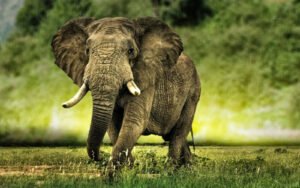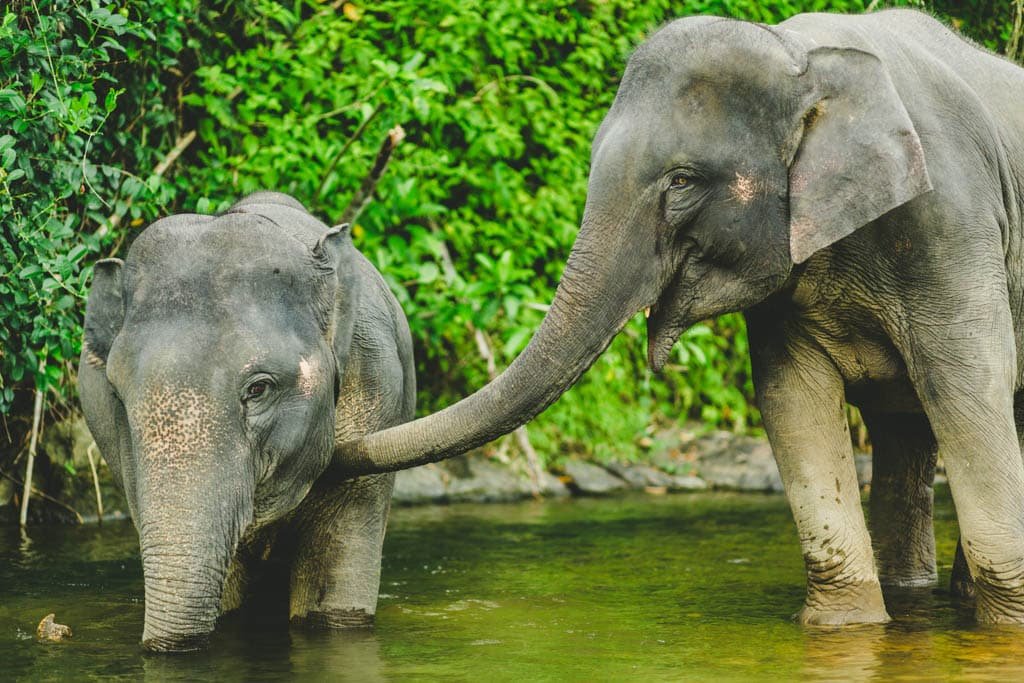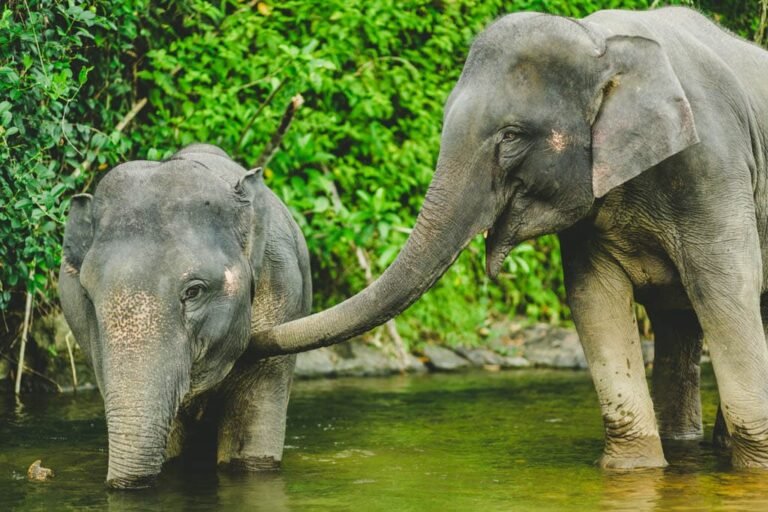Who Is an Elephant
1. Background of the elephant
Who is an elephant?

The word elephant is derived from the Greek word “Elephas” which means ivory. Elephants are the largest land mammals on earth and have distinctly massive bodies, large ears, and long trunks. Historically, elephants were classified into two species, the African elephants (Loxodonta africana) and Asian elephants (Elephas maximus).
There are at least two subspecies of African elephants, namely the Savannah elephants (Loxodonta africana africana) and Forest elephants (Loxodonta africana cyclotis). Forest and savannah elephants are differentiated by geographic distribution and several physical characteristics. African elephants inhabit the Sub-Saharan regions of Africa. The savannah elephant resides on the savannah and grassy plains of East and South Africa. Forest elephants inhabit forested regions of Central and Western Africa. The savannah elephant is larger than the forest subspecies. In fact, it is the largest land animal in the world.
There are four recognized subspecies of Asian elephants, the Sri Lankan subspecies (Elephas maximus maximus) the mainland subspecies (Elephas maximus indicus), the Borneo subspecies (Elephas maximus borneensis), and the Sumatran subspecies (Elephas maximus sumatranus). Asian elephants inhabit the Southern, Eastern, and South Eastern parts of Asia. The Indian elephant (E.m. indicus) has the broadest distribution, extending between the southern and south-eastern regions of Asia. Sumatran (E.m. sumatrensis) and Sri Lankan (E.m. maximus) elephants inhabit Sumatra and the south-western parts of Sri Lanka respectively. Borneo elephants inhabit Sabah, Malaysia, and Kalimantan regions of Borneo. The Sri Lankan elephant is the largest of all three Asian elephant subspecies. The Borneo elephant subspecies was identified in 2003. They are the smallest in size and have the longest tail length of all four species, often touching the ground. This species is native to Asia and is smaller than its African counterparts. Asian elephants are known for their smaller ears and a more rounded back. They have historically been used for various purposes by humans, such as transportation and heavy labour.
African Elephant (Loxodonta africana and Loxodonta cyclotis):
- African elephants are the largest land animals on Earth.
- They are divided into two subspecies: the African forest elephant and the African savannah (or bush) elephant.
- They inhabit a range of habitats, from dense forests to savannah and grasslands.
- African elephants have larger ears, with a shape similar to the African continent.
Asian Elephant (Elephas maximus):
- Asian elephants are smaller than African elephants.
- They have smaller ears and a single “finger-like” projection at the end of their trunk.
- Asian elephants are further divided into several subspecies and are found in a variety of habitats across Asia, including grasslands, forests, and wetlands.
- Some Asian elephants have been historically domesticated and used for various purposes, such as logging and transportation.
An elephant is a large, herbivorous mammal belonging to the family Elephantidae. Elephants are known for their distinctive appearance, which includes a long trunk, large ears, tusks (in some species and individuals) and typically thick, grey skin. Elephants are known for their intelligence, social behaviour, and complex emotions. Elephants are highly intelligent creatures with complex social structures. They live in tight-knit family groups led by a matriarch (grandmother), usually the oldest and most experienced female. These groups are composed of related females and their children. Adult males tend to live more solitary lives or form smaller groups outside of the family units.
One of the most distinctive features of elephants is their trunk, which is actually a fusion of their nose and upper lip. The trunk is incredibly versatile and serves a variety of purposes, including breathing, touching, grasping objects, and even communication through various sounds.
Due to their large size, elephants play important roles in the ecosystems they inhabit, such as shaping landscapes and spreading seeds. Unfortunately, elephants have faced numerous threats, including habitat loss, poaching for ivory, and conflicts with humans. Conservation efforts are ongoing to protect and preserve these magnificent creatures and their habitats. They are some of the most recognizable and iconic animals on Earth. Here’s a bit more about elephants:
Physical Characteristics: Elephants are characterized by their massive size, with the African
elephant being the largest land animal on the planet. They have a thick, greyish skin that is thinly covered in rough hair. Their large ears help regulate body temperature, and their trunks are extended muscular structures that serve as a multipurpose tool for various tasks like clutching objects, lifting food and water, and even communicating.
An elephant trunk has up to 40,000 muscles. A human has more than 600 muscles in the entire body. Elephants use their trunks to help them suck up water for drinking, pick up or touch objects, trumpet warnings, and greet one another. Elephant tusks serve many purposes. These extended teeth can be used to protect the elephant’s trunk, lift and move objects, gather food, and strip bark from trees. They can also be used for defence. During times of drought, elephants even use their tusks to dig holes to find water underground. Elephant tusks are actually teeth that extend beyond their mouths. They are connected to the skull and have nerve endings, just like our own teeth. Once a tusk is broken, damaged, or removed, it stays that way.
Habitat: Elephants can be found in various habitats, including savannah, forests, grasslands, and even deserts. Their natural ranges are primarily in Africa and Asia.
Social Structure: Elephants are known for their complex social structures. They live in groups called herds, which are usually led by an older female known as the matriarch. Male elephants often live alone or in smaller groups, and they may have periods of social interaction with other males and females.
Behaviour: Elephants are intelligent and emotionally complex animals. They exhibit a range of behaviours, including communication through languages, body language, and infrasound. (low-frequency sounds that humans can’t hear). They also display empathy, sorrow, and cooperative behaviour within their groups.
Conservation: Elephants face significant conservation challenges due to habitat loss, poaching for their ivory tusks, and human-wildlife conflicts. The illegal ivory trade has led to a strong decline in elephant populations in some regions. Conservation efforts are underway to protect and preserve these majestic animals.
Cultural Significance: Elephants hold cultural and religious significance in many societies. They have been revered as symbols of wisdom, strength, and good luck in various cultures around the world.
In recent years, there has been a growing awareness of the importance of protecting elephants and their habitats. Efforts are being made to combat poaching, improve conservation practices, and promote coexistence between humans and elephants to ensure the survival of these remarkable creatures.
Elephants play a crucial role in maintaining the balance of their ecosystems through activities like seed spreading and shaping vegetation. They are also important cultural symbols in various societies and religions around the world. Unfortunately, elephants have faced significant threats from habitat loss, poaching for their ivory tusks, and human-wildlife conflicts. Conservation efforts have been underway to protect and preserve these magnificent animals and their ecosystems.
The animal has been closely associated with man since proto-historic times, for tamed elephant figures in ancient Egyptian paintings and Assyrian carvings. Its semi-domestication for service was first commenced in India and Ceylon and the science was spread far afield by Indian mahouts who were employed to train war elephants for other nations.
2.Difference between Asian & African elephant
Asian and African elephants are two distinct species within the elephant family. While they share many common features due to their shared evolutionary history, they also have several differences in terms of physical characteristics, behaviour, habitat, and more. Here’s an overview of some key differences between Asian and African elephants:
Asian Elephant

Asian and African elephants are two distinct species within the elephant family. While they share many common features due to their shared evolutionary history, they also have several differences in terms of physical characteristics, behaviour, habitat, and more. Here’s an overview of some key differences between Asian and African elephants:
- Asian elephants are smaller than African elephants.
- Standing around 8 to 10 feet tall at the shoulder and weighing between 3,000 to 5,000 kg (6,600 to 11,000 pounds).
- They inhabit a range of ecosystems, including grasslands, forests, and even mountainous regions, across several Asian countries, such as India, Thailand, Indonesia, and Sri Lanka.
- Ears are smaller, rounded ears.
- Asian elephants are not as efficient at heat regulation, so they often use other methods, such as mud baths or shade, to stay cool.
- Some male elephants have tusks
- Female Asian elephants typically lack prominent tusks, or they may have smaller, less noticeable ones.
- Trunks typically have only one, which is used for grasping objects.
- Asian elephants also exhibit social behaviour, their groups are generally smaller and less structured compared to African elephants.
- Both species are herbivores.
- Their diet is typically more selective, and they might feed on a narrower range of plants. They consume less food overall compared to African. elephants.
- Mainly feed on grasses, leaves, and bark.
- They are known for their domestication and have been used by humans for various tasks, such as logging and transportation.
- Less aggressive compared to African elephants.
African Elephant

- African elephants are the largest land animals on Earth.
- Male African elephants can stand around 10 to 13 feet tall at the shoulder and weigh between 4,500 to 6,800 kg (10,000 to 15,000 pounds).
- They are found across various habitats in Africa, including savannas, forests, and deserts. There are two subspecies: the African savannah elephant and the African forest elephant.
- Large fan-shaped ears, shaped somewhat like the African continent
- Their large ears help regulate body temperature by radiating excess heat. The ears’ larger surface area allows for efficient cooling.
- Both male and female elephants grow tusks
- Trunks tend to have two “fingers” at the tip, which makes it more versatile for various tasks.
- African elephants are known for their complex social structures. They often live in larger, matriarchal family groups led by an older female.
- Both species are herbivores.
- Due to their larger size, African elephants tend to require more food. They have a more varied diet that includes a wide range of plant materials.
- African elephants have been less commonly domesticated due to their larger size and unpredictable behaviour. more
- Often considered more aggressive and unpredictable compared to Asian elephants. They may exhibit more challenging behaviour in captivity.
Both Asian and African elephants have had historical and cultural significance in various societies. They have been used for labour, transportation, and ceremonial purposes. However, the role and relationship between humans and elephants vary across different regions and cultures.





